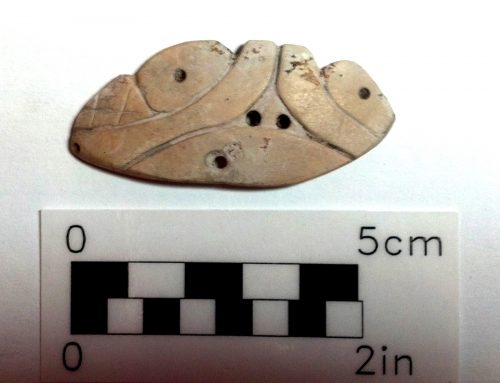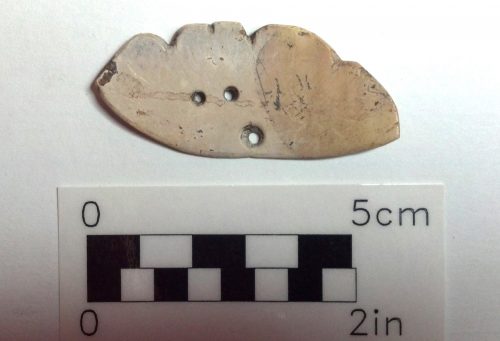A few years ago a new house was built on Brown’s Complex Mound 4, a part of the Pineland Site Complex that is still in private ownership. In order to build on the shoreline, where winds can sometimes be very strong, the owners were required to have footer holes and trenches dug so that a substantial concrete structure could anchor the house to the shell mound below.

Grace
Before the concrete was to be poured, the RRC examined the footer holes and trenches and documented the layers of the shell midden. We were funded by the owners and assisted by RRC volunteers. A report was prepared by John Dietler, and then construction proceeded. The owners offered to have some of the disturbed midden materials dumped at a place of our choosing, and so a truckload was deposited at the Ruby Gill House, our nearby headquarters building.
Since that time, volunteers have gathered weekly to sift the disturbed midden through ¼-inch screen, looking for artifacts. Pat and David Townsend have coordinated the effort, assisted regularly by Polly Eldred, Pat Yourdon, and many others. The artifacts are carefully washed and catalogued in the laboratory by the same volunteers.
Most of the time, the screens yield pottery fragments, shell tools, and the occasional broken bone tool. The amount of information that we can derive from these finds is limited because their context has been lost. In other words, artifacts by themselves may be interesting, but in order to yield information useful to the archaeologist, they must be excavated carefully and documented meticulously. As Robin Brown likes to say, “It isn’t what you find that’s interesting, but what you find out.” The sifting does provide training for our volunteers, however, and the artifacts they find are very useful for educational programs. A few weeks ago, new volunteer Lawrencine Mazzoli picked a thin, oval object out of the screen and held it up for the others to see. When it had been dusted off and examined, all agreed it had been carved from shell. Since then, many people have seen the artifact, and many creative interpretations have been suggested. Most people see animals, but there is little consensus about what animals are represented.
What can we say about it? It is a complete engraved shell artifact. The edges are finished and smoothed. Three carefully drilled holes go all the way through the object, possibly for attaching to an item of clothing. Three other holes do not go all the way through, suggesting that they are part of the intended design. The drilling and engraving (curvilinear lines and the cross-hatching) were probably done using a shark’s tooth. The shell used is probably lightning whelk, a marine snail shell found in Pine Island Sound.

Grace
The materials in which the artifact was discovered are out of context, but the part of Mound 4 from which they came dates to the Caloosahatchee III and IV periods, based on pottery identified by Dietler. Therefore, the carved shell artifact is almost surely between 500 and 800 years old. It would be possible to date it directly by AMS radiocarbon dating, but only by drilling into it to extract a small amount of shell.
As for the design, which is in relief, it appears that two or more animals are represented, but what are they? Suggestions so far have included otter, gopher tortoise, manatee, sea turtle, rattlesnake, and crab. Two people have independently suggested that it was once a circular gorget (an ornament worn at the throat), but that it broke and was re-worked into its present form. However, unlike most of the circular gorgets that were so important in the Native American cultures of the southeastern U.S. around 500-800 years ago, our artifact is carved into the outer, not the inner, surface of the whelk shell, a fact that was brought to my attention by James Brown, a renowned expert on Native American art and symbolism. Dr. Brown added that “it is indeed interesting and very unusual, perhaps belonging to a new form.”
So, although all the artifacts that our screeners find are interesting, this one is pretty special. Without context, we cannot say what its function was, or with whom it was associated. Was the artifact associated with a house? inside? outside? Was it the house of a high-status individual, perhaps a leader, or was it in a trash pile? Was it in association with pottery known for a specific time period? with certain animal bones? certain shells? Because that part of Mound 4 was destroyed, none of this information will ever be known. We can only hope that the next time such an unusual artifact is found, it will be in a controlled excavation, and then we will be able to do more than just appreciate its beauty and workmanship.
This article was taken from the Friends of the Randell Research Center Newsletter Vol 11, No. 1. September 2012.